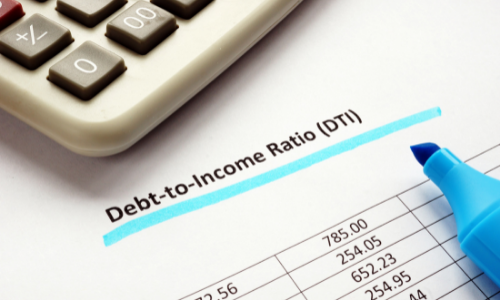Your debt-to-income (DTI) ratio: what it is and why it matters
 Beyond your credit report and credit score, your debt-to-income (DTI) ratio can also impact your ability to borrow money. It's a way for lenders to asses your ability to pay back your loans. Here's how it works and what you can do to improve your DTI.
Beyond your credit report and credit score, your debt-to-income (DTI) ratio can also impact your ability to borrow money. It's a way for lenders to asses your ability to pay back your loans. Here's how it works and what you can do to improve your DTI.
What it is and how it matters
Your DTI is determined by taking the sum of your monthly debt payments and dividing them by your gross monthly income. The debt payments taken into consideration are typically those that show up on a credit report, such as mortgage payment, loan and credit card payments, student loan payments, etc. If you rent, your monthly rental payment will be used for the calculation. A low DTI can mean that you don't have excessive debt to pay in relation to your income. a high DTI can mean that most of your income goes towards paying off debts. This can cause some lenders to see you as a high risk - potentially leading to the rejection of your loan application, regardless of your payment history and your credit score.
If you're in the market for a new loan, especially a mortgage loan, be mindful of your DTI, as many lenders aren't able to able to offer a Qualified Mortgage unless the borrower's DTI ratio is 43% or lower. Qualified Mortgages are meant to provide extra protections to consumers are less likely to result in a borrower defaulting on their loan.
Calculating your DTI Ratio
Here's an example of how calculating a DTI ratio might look:
Joe Member has the following monthly debt payments: $1,500 in rent, $350 for an auto loan, $300 for a student loan, and $100 minimum payment on a credit card, for a total of $2,250 in total monthly debt payments. It's important to note that things like utilities, mobile phone bills, etc. aren't included. Only debts that appear on your credit report are included.
Now, to calculate the income part of the ratio, which will be his monthly gross income. Joe makes an annual salary of $60,000 a year. This is before taxes and other deductions for health insurance, life insurance, 401(k) contributions, etc. His yearly salary of $60,000 breaks down to a gross monthly income of $5,000. Divide the $2,250 in debt payments by $5,000 and his DTI ratio is 45%.
How to Lower your DTI ratio
There are 2 ways to lower your DTI ratio: increase your income or reduce your debt
To increase your income, you can:
- think about ways to make extra cash - extra shifts, working a side hustle, etc
- list all your debts and use the avalanche or snowball method to tackle them
To reduce your debt, you can:
- refinance your loans or consolidate your debt
- make extra payments temporarily to pay off some loans early
If you have additional questions about your DTI ratio, we're here to help. Give us a call at 901-380-7400 or stop by any of our banking centers for more information on how we can help you refinance or consolidate your loans, which can help save you money and improve your DTI ratio.
This is article is intended for general information purposes only and is not legal, tax or financial advice. Please consult your tax or financial advisor for specific information regarding your financial situation.
« Return to "Blog"



